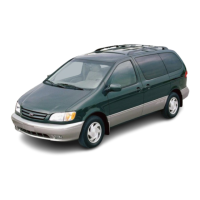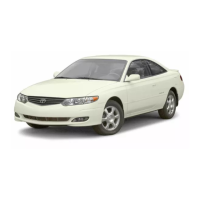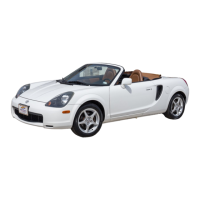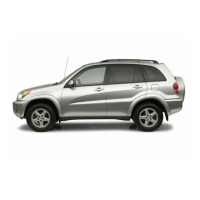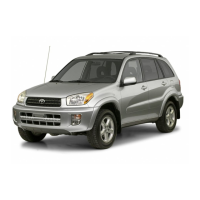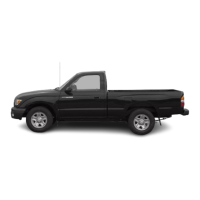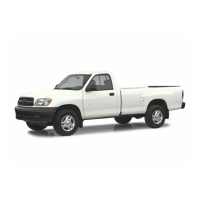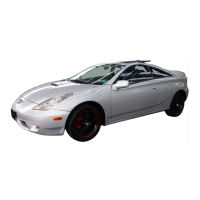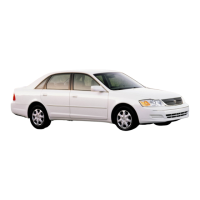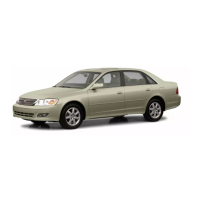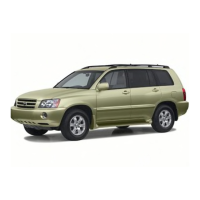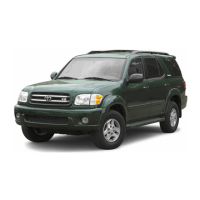
 Loading...
Loading...
Do you have a question about the Toyota 2002 Sequoia and is the answer not in the manual?
| Brand | Toyota |
|---|---|
| Model | 2002 Sequoia |
| Category | Automobile |
| Language | English |
Explains types of warnings, their appearance, and usage.
Explains the meaning of the general safety symbol.
Details Toyota's limited warranties for new vehicles.
Outlines owner's duty to ensure specified maintenance is performed.
Discusses non-genuine parts and potential warranty/performance issues.
Lists topics: instrument panel and cluster overviews, indicator symbols.
Explains master and sub keys, transponder chips, and key number plate.
Precautions when using keys with transponder chips.
Explains the purpose and importance of the key number plate.
Details how to lock and unlock doors using the key.
Explains operation of the inside lock knob for doors.
Describes the different modes for automatic door locking and unlocking.
Explains operation of the wireless remote for locking and unlocking.
How to open the back window using the remote transmitter.
How to operate windows from inside the car.
Details on operating front windows and the window lock switch.
Details the function that stops closing windows if an obstruction is detected.
How to open/close front windows using the key from outside.
How to operate the back window from inside the vehicle.
How to operate the back window from outside the vehicle.
How to lock/unlock the back door with the key.
Refers to wireless remote control operation for the back window.
Steps to set the theft deterrent system.
Conditions under which the theft deterrent system activates the alarm.
How to open and close the moon roof via sliding.
How to tilt the moon roof up or down.
Detailed steps for sliding moon roof operation.
Explanation of the moon roof's jam protection feature.
Lists topics related to seats, seat belts, steering wheel, and mirrors.
Lists topics related to front seats and safety precautions.
Safety precautions for front seats, especially with side airbags.
Precautions for adjusting seats to avoid injury or loss of control.
Safety precautions related to rear seats and potential injuries.
How to adjust lumbar support for seats.
General safety precautions for using seat belts, including for children and pregnant women.
Safety advice on shoulder belt positioning to prevent injury.
Explains how to correctly match buckles and tabs for the center seat belt.
General precautions for using child restraint systems.
Safety checks for top strap installation and overall security.
Safety checks for top strap installation and overall security.
Instructions for installing Type A child restraint systems.
Instructions for installing Type B child restraint systems.
Instructions for installing Type A child restraint systems.
Instructions for installing Type B child restraint systems.
How to adjust and operate power rear view mirrors.
How to use vanity mirrors and vanity lights.
Lists topics: headlights, wipers, defoggers, and related controls.
How to use turn signals for turns and lane changes.
How to use turn signals for turns and lane changes.
How to activate and use the emergency flashers.
How to turn the interior light on, off, or use the DOOR setting.
How the interior light operates when doors are opened or closed.
How to turn the center personal light on and off.
Lists topics: fuel gauge, coolant temp, oil pressure, volt meter, tachometer, odometer, trip meters, and warning indicators.
Warning about driving with low oil pressure.
Explains the brake system warning light and precautions.
Critical warnings if the brake system warning light remains on.
Function of front passenger's seat belt reminder light.
What the discharge warning light indicates and actions to take.
Meaning of the malfunction indicator lamp and troubleshooting.
Function of the ABS warning light and precautions.
Critical warnings if ABS and brake system lights are on together.
What the open door warning light indicates.
Meaning of the SRS warning light and what it monitors.
Function of the key reminder buzzer.
What the unengaged "Park" warning light indicates.
Warning about continued driving with the warning light on.
What the low washer fluid warning light indicates.
How to check the function of service reminder indicators.
Lists topics: ignition switch, transmission, parking brake, and cruise control.
Explains the selector lever positions and their functions.
Steps for normal driving with the automatic transmission.
Warning about downshifting on slippery surfaces.
When and how to use the "2" and "L" positions for engine braking.
Steps for parking the vehicle correctly.
General tips for good driving practices.
Warning about shifting modes when wheels are slipping.
Warning about shifting modes when wheels are slipping.
How to turn the cruise control system on and off.
Warning to keep the cruise control switch off when not in use.
Lists topics: reference, using the system, and operating hints.
Basic features of Toyota audio systems, turning the system on/off, and switching functions.
Details of buttons, controls, and features for Type 1 audio system.
How to adjust bass, midrange, and treble settings.
How to adjust bass, midrange, and treble settings.
Diagram and list of controls for the front air conditioning system.
Diagram and list of controls for the rear air conditioning system.
Lists various other equipment: clock, power outlets, glove box, etc.
Diagram and list of controls for the multi-information display.
How the E/M button switches between English and metric units.
Steps for programming the HomeLink buttons.
Steps for programming devices with rolling codes.
Steps for programming entrance gates and Canadian market devices.
How to reprogram a single HomeLink button.
How to operate the HomeLink system.
How to erase all programmed HomeLink codes.
How to use the cigarette lighter and front ashtray.
How to use the rear ashtray.
How to access the upper tray of the console box.
How to access the rear console box and CAUTION for safety.
Lists topics before driving: off-road precautions, break-in, fuel, etc.
Warning about using gasohol and driveability problems.
Procedure for restarting the engine after the fuel pump shut off system activates.
Precautions to prevent catalytic converter damage and fire hazards.
Why checking engine oil level regularly is important and Toyota's recommendation.
How the brake booster works and its limitations.
Function of the ABS warning light and what it indicates.
Critical warning if ABS and brake system lights are on together.
Information about the parking brake system.
Precautions for stowing luggage and cargo safely in the vehicle.
Warning about vehicle capacity weight limits.
Location and purpose of the vehicle identification number (VIN).
Location of the engine number.
Critical warning if ABS and brake system lights are on together.
Information about the parking brake system.
Lists topics related to starting and driving the vehicle.
Normal starting procedure and what to do if the engine stalls.
Warning to use only specified ball mount attachments.
Recommendations for trailer brakes and safety chains.
Requirement for trailer brakes if total weight exceeds 453 kg.
How to connect and operate trailer lights, and compliance with regulations.
Lists emergency situations and corresponding procedures.
Basic checks to perform if the vehicle will not start.
Warning against push-starting and catalytic converter damage.
Troubleshooting steps for a slow or non-cranking engine.
Procedure for starting a flooded engine.
Warning about cranking the engine for too long.
What to do if the engine still will not start after following procedures.
To help avoid personal injury, keep the hood closed until there is no steam.
Steps to take when experiencing a flat tire, including CAUTIONS and NOTICE.
Warning against driving with a deflated tire.
How to remove wheel ornaments.
How to position the jack correctly at the designated jack points.
Steps and CAUTIONS for raising the vehicle with a jack.
How to reinstall and tighten wheel nuts.
How to reinstall wheel ornaments.
Final CAUTION about securing tools and tire before driving.
Warning about using specified towing hooks and potential damage.
Extreme caution advised for emergency towing and potential stress on equipment.
Warning about using only specified towing cables/chains.
Precautions when using the emergency towing hook and seeking assistance.
Topics on preventing corrosion and maintaining vehicle appearance.
Steps for hand-washing the vehicle, including CAUTIONS.
How to clean vinyl upholstery.
How to clean carpets using foam shampoo.
How to clean seat belts and precautions.
How to clean interior panels and switches, with NOTICE about cleaning agents.
Lists topics related to DIY maintenance.
Explains the importance of maintenance and owner's responsibility.
Information on scheduled maintenance items and guides.
Information on Toyota dealer services and DIY maintenance.
Maintenance checks for the exterior of the vehicle.
How often to check tire pressure and the importance of proper inflation.
How to check tires for damage and wheel nuts for tightness.
When to rotate tires and how it affects wear.
How to check for fluid leaks and what to do if found.
Checks for doors and engine hood operation and latch security.
How to check all exterior and interior lights.
How to check the function of service reminder indicators.
How to check steering wheel play and condition.
Checks for seat controls, seatbacks, and rear seat mechanisms.
How to check seat belt systems for proper operation and condition.
How to check accelerator pedal operation.
How to check brake pedal operation and clearance.
How to check brake performance and parking brake function.
How to check the selector lever lock release and parking mechanism.
Maintenance checks for items in the engine compartment.
How to check washer fluid level and type.
How to check engine coolant level and add coolant if needed.
How to check the radiator, condenser, and hoses for cleanliness.
Lists topics related to DIY maintenance.
How to check the engine oil level and add oil if needed.
Instructions for checking tire pressure when tires are cold.
Guidelines for selecting replacement wheels.
Warnings about snow tire inflation and speed limits.
How to select and install tire chains.
Guidelines for selecting replacement wheels.
Lists topics related to DIY electrical maintenance.
Precautions for battery maintenance and safety.
Detailed safety precautions when working with batteries.
Emergency procedures for electrolyte contact or ingestion.
How to check the battery exterior for corrosion or loose connections.
How to check battery condition using the indicator color.
Precautions and steps for recharging the vehicle battery.
Warnings about battery recharging in confined areas and charge rates.
Advice on using substitute fuses and the importance of spare fuses.
Warning against using fuses with higher amperage ratings.
How to access and replace front fog light bulbs, with a NOTICE about replacing them.
Lists vehicle specifications: dimensions, engine, fuel, tires, fuses.
Engine service specifications.
Engine oil capacity, grade, and viscosity recommendations.
Engine service specifications.
Engine oil capacity, grade, and viscosity recommendations.
Information on reporting safety defects and tire quality grading.
